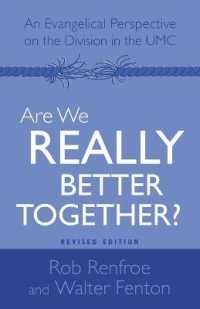Full Description
The Routledge International Handbook of Sensory Criminology reimagines what criminology can become when we take the senses seriously. Centring the sensory as fundamental to the experience of harm, justice, and resistance, this groundbreaking volume brings together 29 chapters from scholars across disciplines, career stages, and geographies. Together, they explore how power is heard, felt, inhaled, touched, and moved through, from courtrooms and prisons to museums, marine ecologies, colonial archives, transitional spaces, high-crime zones and urban streets.
The Handbook opens up new pathways for criminological inquiry, offering rich, situated analysis of how the sensory shapes and is shaped by structures of criminalisation, exclusion, and survival. Contributors engage themes including punishment, victimhood, environmental harm, archival memory, decolonial justice, and innovative methodologies. Rather than offering a prescriptive vision, the volume offers a provocation: to expand the criminological imagination and embrace new ways of knowing, sensing, and intervening.
This Handbook is an essential reading for students, scholars and early career researchers in criminology, sociology, law, anthropology, geography, gender studies, politics, and cultural studies, as well as those interested in decolonial approaches, sensory methods, and interdisciplinary justice research.
Contents
Section i: Sensory Criminology: Expanding our Imagination, Introduction: Sensing Violence: Traces, Echoes, and Afterlives 1. Listening to Donald Trump's Voice: 'Fight like hell!', the Capitol Hill Riots, and the Spectre of Teleprompter Trump 2. 'SHUT YOUR FUCKING MOUTH': Sound, Silence and Gender-Based Violence 3. The Sound of Violence 5. War, Colonialism and the Senses: "You can't unsee or unhear that shit" Section II: Coloniality, Imperialism, and the Senses Introdcution: Recognising Abhorrent Legacies: Lessons for Sensory Criminology 5. Doing Justice Differently: A Pan-Africanist Perspective 6. "I'll Make You Shit!": Olfactory Othering and the Necropolitics of Colonial Prisons 7. The Sensory Aspects of Abhorrent Heritage in South Africa 8. Decolonizing Sensory Rhetorics and Activism in Africana Prison Memoirs Section III: Sensory, Narrative, and the Arts Introduction: Reimagining Justice through Creative Encounters and Sensory Knowing 9. Black light. Drawing, Music and Theatre as Sensory Practices in the Encounter Between Incarcerated People and University Students 10. Crackle and Flicker: Music and Multisensory Experiences in Prison 11. Seeing Museums as Criminological Spaces: An Affective Tale of Two Museum Visits 12. 'Verily in the remembrance of Allah do hearts find rest:' Sensory Criminology, Islamic Auditory Traditions, and the Rehabilitation of Offenders Section IV: Sensing (In)Justice Introduction: From the Courtroom to the Street: The Sensory Dimensions of Racialised (In)justice 13. Conflicting Senses, Victims, and the Courtroom: the case of Cindy Gladue 14. The Sensory Effects of Racial Profiling in Berlin's KBO's 15. Racialized Punishment and the Sensorial Symbolism of Death Row for America's Black Gangster Class Section V: Environmental Harm and the Senses Introduction: "The Way the Soil Crumbled in Their Hands": Sensing Environmental Harms 16. Seeing and Sensing Environmental Harm: The Death of the British Countryside 17. The Sensory Ocean: Exploring Noise and Light Pollution as Blue Crime 18. Sensitising Criminology to Experiences of Environmental Noise Section 6: Space, Place, and the Sensory Introduction: Vivid and Vibrant Criminological Landscapes: Sense and Space 19. Dispossessed Realities: Houselessness, and Spatial Violence 20. Release from Prison Day 21. "I can't breathe" Housing, Masculinities and Violence in Cape Town, South Africa 22. Scrutinising Social Control in the City through the Senses Section 7: Time, Justice, and the Sensory Introduction: 23. Sitting, Seeing and Getting Lost: The Sensory Aesthetics of Latvia's Women's Prison 24. Time, Temporality, and Chronoception 25. It's a Circus: The Production of Domestic Violence Proceedings in Lower Courts of Mumbai, India 26. Beholding Justice: Images of Punishment in Medieval and Early Modern Europe Section 8: Sensory Methods Introduction: "They Are Not Like You and I": Sensory Methods 27. Sense and Insensibility: How Technologies Invite and Invisibilise Harm 28. Audio Criminology: Broadening the Criminological Imagination Through the Use of Audio Methods 29. 'Still feels like jail': Sensing Danger, Bleakness and Friendship in a State-Run Home For Boys





